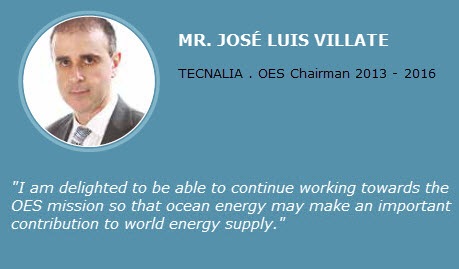Chairman’s Message
|
|
Mid-way through the third 5-year mandate and fourteen years after its foundation, the OES is continuing to grow with two new members joining in 2014: Singapore and The Netherlands, making a total of 23 countries. This growth is assisting us in our mission of international collaboration to accelerate the viability, uptake and acceptance of ocean energy systems in an environmentally acceptable way. To fulfil this mission, the OES has been setting up new activities and consolidating on-going ones. In 2014, the OES Executive Committee decided to start up two new projects on Ocean Thermal Energy Conversion and technology roadmapping. Furthermore, we have identified other topics of interest to work on in 2015 such as numerical modelling validation, best practice for open water test centres, policies to local wave energy resource characteristics, ocean energy applications in remote areas, mooring systems or a sensors database. As far as current activities, I would like to highlight two web tools: |
- Tethys, an online knowledge management system, which currently includes 82 project sites and 57 research studies and it continues to expand and to increase user interactions;
- and the GIS Database for Ocean Energy, an interactive web application with detailed global information such as ocean energy facilities, resources, relevant infrastructure, in conjunction with the respective location on a global map.
Greater repercussion for these activities has also been sought through international collaboration. In this context, a notable contribution was made with our support to the organisation of ICOE2014, held in Halifax, Canada, in November. The OES had its Executive Committee meeting immediately after this event. Previously we had held another Executive Committee meeting at the IEA headquarters in Paris to engage with IEA experts in technology roadmapping. Concurrently with this meeting a workshop was also run on “Exploring the Prospects for Marine Renewable Energy to 2030” to feed inputs to an OECD project on the “Future of the Ocean Economy”.
The OES participation in the European Ocean Energy Forum, in particular in a working group on Environment and Consenting issues, is also worth mentioning. The OES mission is a long term one; ocean energy is still a small actor in the energy landscape. The contribution from ocean energy is very low and will not be significant in the foreseeable future. The global economic downturn is not helping to accelerate ocean energy development and we are living through some uncertainties affecting iconic ocean energy companies. On the other hand, we have seen real commitment from some project developers and, as the OES Chairman, I am very happy to see three of them giving their views here about ocean energy challenges and opportunities. I would like to thank DP Energy, EMERA and ESB for their contribution to this annual report.
I could not finish this address without giving thanks for the great effort shown by delegates from the member countries and in particular for entrusting me to continue as Chairman for two more years. I would like to give special thanks to the two Vice-Chairmen who left their positions in 2014: Eoin Sweeney (Ireland) and Michel Reed (US). May I also welcome our two new Vice-Chairmen Keyyong Hong (Republic of Korea) and Henry Jeffrey (UK). I am delighted to be able to continue working towards the OES mission so that ocean energy may make an important contribution to world energy supply. It is a pleasure for me to work with a magnificent team and the tireless support of Ana Brito e Melo, OES Secretary, who will now introduce the contents of this Report.




